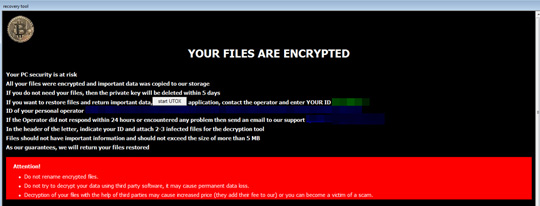Ransom.Win64.CRYTOX.A
Windows


Threat Type: Ransomware
Destructiveness: No
Encrypted: Yes
In the wild: Yes
OVERVIEW
Downloaded from the Internet, Dropped by other malware
This Ransomware arrives on a system as a file dropped by other malware or as a file downloaded unknowingly by users when visiting malicious sites.
It deletes itself after execution.
It drops files as ransom note. It avoids encrypting files with the following file extensions.
TECHNICAL DETAILS
1,674,752 bytes
EXE
Yes
11 Feb 2020
Displays graphics/image
Arrival Details
This Ransomware arrives on a system as a file dropped by other malware or as a file downloaded unknowingly by users when visiting malicious sites.
Installation
This Ransomware drops the following files:
- %Windows%\Utox.exe → peer-to-peer application used to communicate with attackers
- %Windows%\rwjfk.bat → deletes shadow copies and deletes all logged tokens of wevtutil.exe
- %Windows%\pghdn.txt → deletes shadow copies
(Note: %Windows% is the Windows folder, where it usually is C:\Windows on all Windows operating system versions.)
It adds the following processes:
- vssadmin delete shadows /all /quiet → Delete shadow copies
- explorer.exe
- %Windows%\rwjfk.bat
- %Windows%\pghdn.txt
(Note: %Windows% is the Windows folder, where it usually is C:\Windows on all Windows operating system versions.)
It adds the following mutexes to ensure that only one of its copies runs at any one time:
- itkd{4 random characters}
It injects codes into the following process(es):
- svchost.exe
- explorer.exe
Autostart Technique
This Ransomware adds the following registry entries to enable its automatic execution at every system startup:
HKEY_LOCAL_MACHINE\SOFTWARE\Microsoft\
Windows\CurrentVersion\Run
open = %System Roo%:\ReadMe.hta
Other System Modifications
This Ransomware adds the following registry entries as part of its installation routine:
HKEY_CLASSES_ROOT\.waiting\shell\
open\command
{Default} = %System%\mshta.exe "%System Root%:\ReadMe.hta"
HKEY_CLASSES_ROOT\.waiting\shell\
open\command
en = {HEX VALUES}
HKEY_CLASSES_ROOT\.waiting\shell\
open\command
n = {HEX VALUES}
Process Termination
This Ransomware terminates the following processes if found running in the affected system's memory:
- Any processes not included in the list below:
- DLLHOST.EXE
- CMD.EXE
- IEXPLORE.EXE
- CSRSS.EXE
- SPOOLSV.EXE
- RUNDLL32.EXE
- WININIT.EXE
- LOGONUI.EXE
- MSHTA.EXE
- BFSVC.EXE
- MSTSC.EXE
- WEVTUTIL.EXE
- LSASS.EXE
- RDPCLIP.EXE
- TASKLIST.EXE
- SEARCHINDEXER.EXE
- CONHOST.EXE
- SIHOST.EXE
- VSSADMIN.EXE
- WEBSERVICES.EXE
- SVCHOST.EXE
- FONTDRVHOST.EXE
- TASKHOSTW.EXE
- WUDFHOST.EXE
- MSDTS.EXE
- CTFMON.EXE
- SERVICES.EXE
- EXPLORER.EXE
- DISKSHADOW.EXE
- SMSS.EXE
- WMIPRVSE.EXE
- ISSCH.EXE
- SEARCHUI.EXE
- ADAPTERTROUBLESHOOTER.EXE
- TASKMGR.EXE
- SYSTEM
- [SYSTEM PROCESS]
- PROCESSHACKER.EXE
- DFSSVC.EXE
- WINLOGON.EXE
- FIND.EXE
Other Details
This Ransomware does the following:
- It encrypts the files in the following drives:
- Fixed Drives
- Network Drives
- Removable Drives
It deletes itself after execution.
Ransomware Routine
This Ransomware avoids encrypting files with the following strings in their file name:
- ReadMe.hta
It avoids encrypting files found in the following folders:
- %Windows%
(Note: %Windows% is the Windows folder, where it usually is C:\Windows on all Windows operating system versions.)
It appends the following extension to the file name of the encrypted files:
- {Random Characters}.waiting
It drops the following file(s) as ransom note:
- {Encrypted Directory}\ReadMe.hta

It avoids encrypting files with the following file extensions:
- .waiting
SOLUTION
9.850
15.680.04
12 Feb 2020
15.681.00
13 Feb 2020
Step 1
Trend Micro Predictive Machine Learning detects and blocks malware at the first sign of its existence, before it executes on your system. When enabled, your Trend Micro product detects this malware under the following machine learning name:
- Troj.Win32.TRX.XXPE50FFF033
Step 2
Before doing any scans, Windows 7, Windows 8, Windows 8.1, and Windows 10 users must disable System Restore to allow full scanning of their computers.
Step 3
Note that not all files, folders, and registry keys and entries are installed on your computer during this malware's/spyware's/grayware's execution. This may be due to incomplete installation or other operating system conditions. If you do not find the same files/folders/registry information, please proceed to the next step.
Step 4
Restart in Safe Mode
Step 5
Delete this registry value
Important: Editing the Windows Registry incorrectly can lead to irreversible system malfunction. Please do this step only if you know how or you can ask assistance from your system administrator. Else, check this Microsoft article first before modifying your computer's registry.
- In HKEY_LOCAL_MACHINE\SOFTWARE\Microsoft\Windows\CurrentVersion\Run
- open = %System Root%:\ReadMe.hta
- open = %System Root%:\ReadMe.hta
- In HKEY_CLASSES_ROOT\.waiting\shell\open\command
- {Default} = %System%\mshta.exe "System Root%:\ReadMe.hta"
- {Default} = %System%\mshta.exe "System Root%:\ReadMe.hta"
- In HKEY_CLASSES_ROOT\.waiting\shell\open\command
- en = {HEX VALUES}
- en = {HEX VALUES}
- In HKEY_CLASSES_ROOT\.waiting\shell\open\command
- n = {HEX VALUES}
- n = {HEX VALUES}
Step 6
Search and delete this file
- %Windows%\Utox.exe
- %Windows%\rwjfk.bat
- %Windows%\pghdn.txt
Step 7
Restart in normal mode and scan your computer with your Trend Micro product for files detected as Ransom.Win64.CRYTOX.A. If the detected files have already been cleaned, deleted, or quarantined by your Trend Micro product, no further step is required. You may opt to simply delete the quarantined files. Please check this Knowledge Base page for more information.
Step 8
Restore encrypted files from backup.
Step 9
Scan your computer with your Trend Micro product to delete files detected as Ransom.Win64.CRYTOX.A. If the detected files have already been cleaned, deleted, or quarantined by your Trend Micro product, no further step is required. You may opt to simply delete the quarantined files. Please check the following Trend Micro Support pages for more information:
Did this description help? Tell us how we did.

